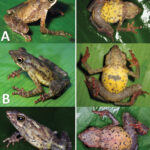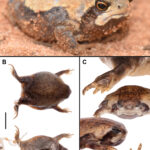- The Majestic Giant Harlequin Toad (Atelopus gigas): A Remarkable Amphibian of the Andes
- Introduction: An Amphibian Enigma in the High Andes
- Taxonomy and Classification
- Natural Habitat: Cloud Forest Streams of the Northern Andes
- Physical Characteristics: A Striking Amphibian of Distinction
- Behavior and Life Cycle: A Dance Along Mountain Streams
- Ecological Role: Guardians of Healthy Ecosystems
- Threats and Conservation Status: An Amphibian in Crisis
- Cultural and Scientific Significance: Symbols of Conservation and Biodiversity
- Conclusion: A Call to Protect Nature's Harlequin Treasure
The Majestic Giant Harlequin Toad (Atelopus gigas): A Remarkable Amphibian of the Andes#
Introduction: An Amphibian Enigma in the High Andes#
Amidst the ethereal cloud montane forests and rushing streams of the northern Andes dwells a creature that effortlessly captures the imagination—the endangered Giant Harlequin Toad, scientifically named Atelopus gigas. Known for its bold colors, striking patterns, and relatively large size compared to other members of its genus, this remarkable amphibian embodies both beauty and fragility in one extraordinary package.
Atelopus gigas, commonly called the Giant Harlequin Toad, belongs to a genus famed for vibrant coloration, which often signals the presence of potent toxins. However, the story of the Giant Harlequin Toad goes far beyond mere color; it is one intricately woven with ecological relevance, cultural significance, and urgent conservation concerns.
Taxonomy and Classification#
Scientifically classified within the family Bufonidae, the Giant Harlequin Toad resides within the genus Atelopus, a collection of distinctive, predominantly brightly colored neotropical amphibians. Currently, the genus consists of over 90 known species, many suffering declining populations due to habitat disruption and disease.
Named by renowned herpetologist George Albert Boulenger in 1906, the taxonomic journey of Atelopus gigas reflects evolving scientific understanding. Its closest relatives include species such as Atelopus ignescens and Atelopus carbonerensis, sharing characteristics such as vibrant coloration, specialized habitat preferences, and vulnerability to extinction pressures.
Natural Habitat: Cloud Forest Streams of the Northern Andes#
The Giant Harlequin Toad demonstrates a notably restricted geographical range, primarily inhabiting montane cloud forests of northern Ecuador and southern Colombia. Within elevations typically ranging between 2000 and 3000 meters, its unique habitat is characterized by persistent mist, lush vegetation, moss-covered rocks, and swift, clean-flowing streams.
These high-altitude forest ecosystems offer ideal conditions for a moisture-dependent amphibian. The cool, damp climate supports abundant insect prey, essential for the toad’s survival, while the clarity and purity of the streams provide critical egg-laying and tadpole habitats.
Within this atmospheric realm of gentle rains and whispering waterfalls, Atelopus gigas displays a remarkable affinity for streamside microhabitats, frequently observed perched atop rocks or logs, their vibrant coloration boldly contrasting with the lush greenery—perhaps warning potential predators of their potent toxicity.
Physical Characteristics: A Striking Amphibian of Distinction#
Among harlequin toads, Atelopus gigas earns its common name honestly—”gigas,” meaning giant. Adults can reach impressive lengths of up to 8 centimeters, considerably larger than many congeners, making this species one of the largest within its genus.
Beyond size, this amphibian boasts striking coloration. Patterns often feature vibrant hues of yellow, green, or orange juxtaposed against deep black backgrounds, forming unique mosaics that not only captivate human observers but also serve a vital biological function. This bright pattern, known as aposematic coloration, warns predators of the powerful skin toxins produced as effective chemical deterrents against predation.
The toad’s sturdy body, well-adapted limbs, and flattened, elongated toes provide excellent gripping capability. This adaptation offers defense against the strong currents of its native streams, ensuring the toad remains securely anchored as it pursues prey or evades danger.
Behavior and Life Cycle: A Dance Along Mountain Streams#
Feeding Habits and Foraging Behavior#
Primarily diurnal, the Giant Harlequin Toad actively hunts a diverse diet of insects such as ants, beetles, and small caterpillars. It employs a sit-and-wait approach, positioning itself strategically on rocks or vegetation adjacent to habitat pathways frequented by prey.
This straightforward hunting strategy relies upon accurate visual acuity and swift tongue projection, enabling rapid capture of unsuspecting insects. The consistency of insect availability within these montane ecosystems further highlights the delicacy and interdependence at the ecological web sustaining this vibrant amphibian.
Breeding, Courtship, and Reproduction#
The reproductive life of Atelopus gigas begins with the unmistakable serenade of male mating calls during the peak rainy season. Males gather alongside streams, producing distinctive vocalizations that resonate through mist-laden valleys, designed to attract their elusive female counterparts.
Following courtship rituals, females deposit clusters of gelatinous eggs beneath submerged rocks and vegetation, strategically placed in areas receiving an abundance of well-oxygenated water. The expedite currents allow offspring to thrive, and newly hatched tadpoles remain close to egg-laying sites, venturing cautiously into calmer, nutrient-rich pools nearby.
Unlike many frog species, the transformation from tadpole to adult toad in Atelopus gigas can require several months, dictated by precise ecological conditions and optimal stream temperatures. Upon metamorphosis, juvenile toads emerge already brightly patterned, miniature replicas of their parents, and begin their terrestrial lives along the stream’s edge.
Ecological Role: Guardians of Healthy Ecosystems#
As both predator and prey, the Giant Harlequin Toad occupies a central ecological niche, indicating the overall health and stability of its fragile Andean habitat. Their presence indicates inherently healthy water conditions and intact ecological relationships.
Moreover, as consumers of insect populations, these amphibians naturally regulate insect populations, supporting ecosystem balance. Tadpoles contribute by feeding on algae and suspended organic matter, maintaining stream clarity and cleanliness, essential for a host of aquatic species.
Threats and Conservation Status: An Amphibian in Crisis#
Unfortunately, the existence of Atelopus gigas stands precariously on the brink. Classified as Critically Endangered (CR) by the IUCN, this species faces an alarming decline due to a multitude of pressures, notably habitat loss, climate change, and the devastating amphibian chytrid fungus (Batrachochytrium dendrobatidis).
Deforestation and agricultural encroachment increasingly fragment their specialized cloud forest habitats, disrupting their critical breeding sites. Pollution from mining activities or agricultural runoff further contaminates streams upon which these sensitive creatures depend.
The chytrid fungus, however, represents perhaps the most devastating single threat. This invasive pathogen has decimated entire populations of amphibians worldwide, particularly impacting montane Andean species in vulnerable habitats. With compromised skin functions, infected individuals face severe disruption in respiration and hydration, proving rapidly fatal without intervention.
Cultural and Scientific Significance: Symbols of Conservation and Biodiversity#
Locally, indigenous communities recognize the Giant Harlequin Toad as emblematic species representing healthy ecosystems. Their declining populations signal broader environmental issues affecting traditional human communities dependent upon pristine natural resources from these mountains.
Scientifically, Atelopus gigas serves as a sentinel organism for researchers monitoring biodiversity loss, climate impacts, and disease dynamics. Toxic compounds produced by their skin have intrigued scientists, leading to the discovery of unique bioactive molecules with potential medicinal applications against various human diseases.
Conclusion: A Call to Protect Nature’s Harlequin Treasure#
In preserving Atelopus gigas, we protect far more than one amphibian species—we safeguard entire habitats teeming with unique and irreplaceable biological diversity. The Giant Harlequin Toad eloquently symbolizes both the beauty and vulnerability of our planet’s remarkable biodiversity, demanding collective stewardship and meaningful conservation action.
To act now and learn more, consider supporting reputable amphibian conservation programs, participating in habitat restoration projects, or raising your voice to advocate habitat protections for these precious cloud forest ecosystems. After all, in preserving the Giant Harlequin Toad, we ultimately preserve a meaningful facet of our shared natural heritage.







